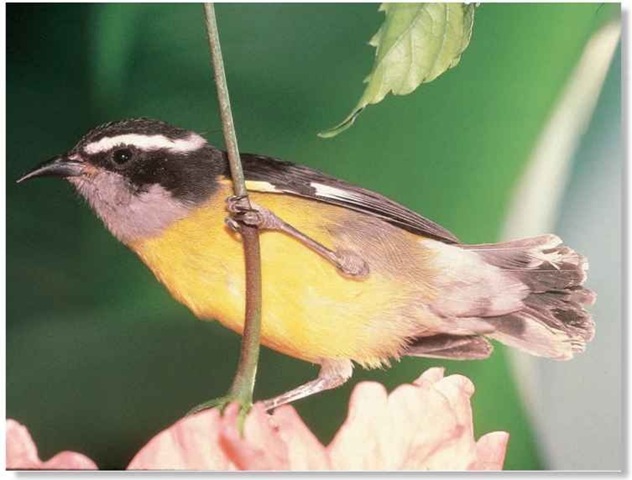ORDER
Passeriformes
FAMILY
Coerebidae
GENUS & SPECIES
KEY FEATURES
Drills a hole in the side of a flower with its long bill, then licks the sweet nectar with its feathered tongue
Builds two types of dome-shaped nests, one for roosting, the other for breeding Despite its name, it does not eat bananas
WHERE IN THE WORLD?
Common in Central and South America, including islands in the Caribbean, excluding Cuba and the Caymans; in North America, only in Florida
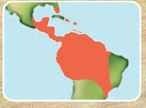
Lifecycle
The nonmigratory bananaquit remains in its tropical habitat year-round, constantly on the lookout for new nectar sources and persistently singing its high-pitched song.
HABITAT
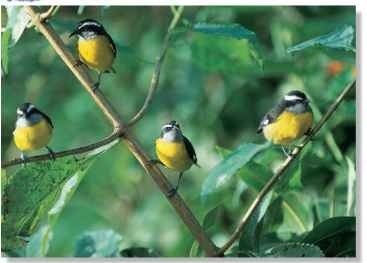
A Flower power Bananaquits search high and low for sweet nectar in a forest.
As its name suggests, the bananaquit is found near bananas. Its prime habitat requirement is an abundance of flowers, its primary food.
The bananaquit lives mainly in tropical regions, including Venezuela, Brazil and the Bahamas, but is also found in subtropical areas and occasionally in temperate regions, as far south as Rio Grande do Sul in South America and as far north as Florida. The bananaquit frequents forests, mangroves, plantations and gardens.
Some bananaquit nests examined in Tobago were composed of 400-650 individual pieces of plant materials.
The bananaquit is the territory bird for the U.S. Virgin Islands.
The bananaquit uses a technique called gaping to eat the inside of pupae, the cocoon stage of developing insects. It pierces the case, opens its bill slightly and licks the inside with its specialized tongue.
FOOD & FEEDING
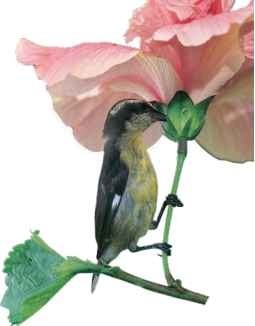
Shortcut to sweets Punching a hole in the flower’s base gets to the nectar more easily.
The bananaquit is always on the move from flower to flower, and from tree to shrub, exploring plants to find nectar. Its favorites include the whorl-like clusters of flowers, called inflorescences, on the banana plant. More than two-thirds of its diet is nectar; the rest is insects and insect larvae. The bananaquit can reach the nectar of some flowers directly from the top, which aids pollination, since pollen sticks to the bird’s facial feathers and bill and is transported to other flowers. But other flowers have nectar that is not as easy to reach. The bananaquit then uses its sharp, awl-like bill to poke a hole in the base of the flower, and sticks out its tongue to lick the carbohydrate-rich fluid. This does not help pollination, but it does assist other animals: when the flower wilts, the hole gets larger, and hummingbirds and insects can reach the leftover nectar. The bananaquit also frequents man-made feeders that contain a mixture of sugar and water and flower-boxes on verandas in towns.
Digging in deep The bananaquit’s beak almost disappears in the petals of some flowers.
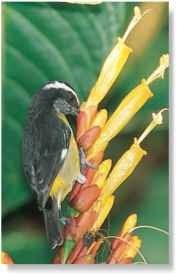
BREEDING
When spring arrives, the bananaquit looks for a mate. Once paired, the birds abandon their own small roosting nest and join together to painstakingly construct an elaborate structure big enough for a family. This thick-walled breeding nest has a high opening almost hidden by a protruding lip, which extends up from the bottom of the nest. The female lays three white eggs with brown spots and incubates them for almost two weeks. Though the male doesn’t help incubate, he helps feed the nestlings regurgitated food. Insects play a more important role than nectar in a chick’s diet — they supply needed protein for growth. The nest is always kept clean; the nestlings’ diaperlike fecal sacs, containing wastes, are either swallowed by the female or carried away. Within three weeks the chicks have fledged.
A CHANGE OF ADDRESS
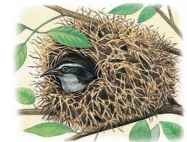
1 Regular roost…
An adult sits in its loosely constructed nest, used throughout the year for daytime rests and overnight roosting.
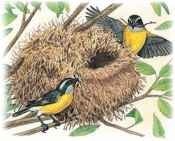
2 Carefully produced…
The breeding nest takes a pair a week to construct; it’s three times as large as the roosting nest, which takes only hours to build.
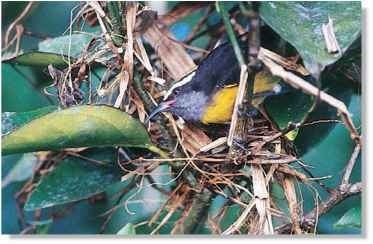
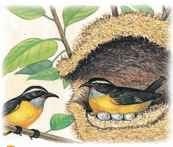
3 Now in use…
The female incubates the eggs during the entire 13-day incubation period. The male brings food and remains close to the nest for protection.
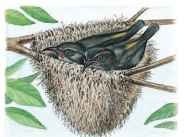
4 Two on the loose
Juveniles must learn to form their own dome-shaped nests, but for the time being, two settle for an abandoned flycatcher’s nest.
BEHAVIOR
The bananaquit is a tireless singer Its hurried, high-pitched call can be heard any time of the day or year. The bananaquit also bathes often. Sticky from its flower foraging, it rinses in rainwater that accumulates in the thick leaves of bromeliad plants, while grabbing an extra meal of mosquito larvae. It cleans its gooey bill by wiping it on the sides on a branch. The bananaquit keeps intruders at bay with rapid wing vibrations. If that doesn’t work, it pecks at its opponent; the fighting birds often flutter down to the ground where they continue their struggle.

A Intense stare A bananaquit carefully scans its territory from its elevated perch.
CONSERVATION
The bananaquit is common throughout its range, and is currently not endangered. Its exploitation of a variety of natural vegetation, as well as hummingbird feeders and urban planters, has contributed to its success. Habitat destruction, as well as insecticide poisoning, could be potential threats in the near future.
Profile
Bananaquit
The bananaquit does not feed on the fruit of the banana tree, but instead uses its sharp bill to reach the sweet nectar of the blossoms.
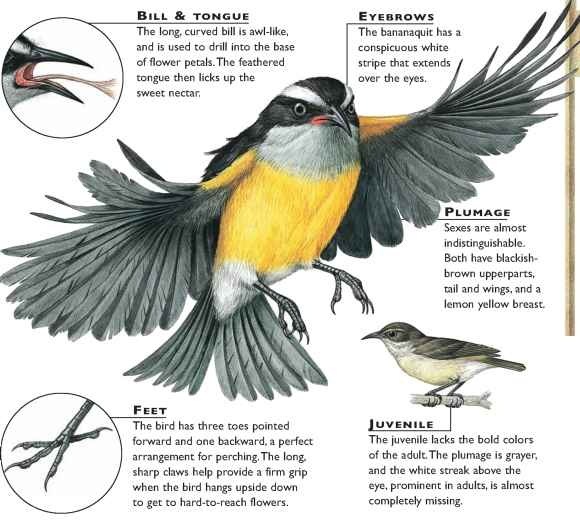
CREATURE COMPARISONS -
The American redstart (Setophaga ruticilla) measures up to 5.75″ and is similar in size to the bananaquit. It joins the bananaquit in the mangroves and forests of Central and South America in the winter, when it migrates south. But in the spring, it returns north to its
breeding grounds in Canada and the United States, while the bananaquit remains in its home year ’round.The American redstart, often called the butterfly warbler, is an active and agile flyer as it pursues flying insects, which are a staple of its diet, while the bananaquit prefers sweet nectar
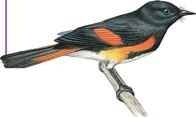
American redstart
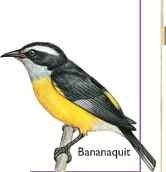
VITAL STATISTICS
Weight 0.35 oz.
Length 4-5″
Sexual Maturity About I year
Breeding March-May ‘Season
Number 3 of Eggs
Incubation 12-13 days Period
Fledging 15-18 days Period
Breeding I year Interval
Typical Mainly nectar,
but also fruits and insects,
including larvae
Lifespan Unknown
RELATED SPECIES
• The bananaquit is the only member of the genus Coereba. It joins about 35 other species in the family Coerebidae, the New World honeycreeper family. The family contains nonmigratory, tropical songbirds that act much like wood warblers, flitting about the foliage in pairs, and includes the slaty flower-piercer, Diglossa baritula. The bananaquit is the only species found in North America.
